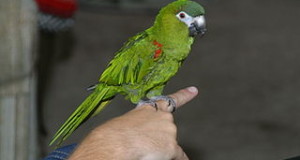 While providing one’s birds with more space is always a good idea, certain precautions must be taken. Please see Part 1 of this article to read about an ugly surprise I was handed by a pair of White-Crested Laughing Jay-Thrushes, Garrulax leucolophus. Today we’ll learn a bit more about these captivating little songsters.
While providing one’s birds with more space is always a good idea, certain precautions must be taken. Please see Part 1 of this article to read about an ugly surprise I was handed by a pair of White-Crested Laughing Jay-Thrushes, Garrulax leucolophus. Today we’ll learn a bit more about these captivating little songsters.
Natural History
White Crested Laughing Jay-Thrushes range throughout much of South and Southeast Asia, and may be encountered from the Eastern slopes of the Himalayas to Vietnam. They frequent forest edges and overgrown scrub, where their flashy plumage and “maniacal”, laughing calls render them among the most conspicuous of all avian residents.
Jay-Thrushes and some related species (please see photo of White-Collared Yunia) live in extended family groups and have complex social behaviors. Youngsters usually stay within their parent’s range for quite some time, and help in rearing subsequent broods.
Zoo Antics
Both wild and captive individuals are playful and curious in the extreme, and never fail to entertain observers (at least when they are not stealing keys or other items…please see Part 1 for some amusing stories). More than one keeper has compared their intelligence and sociability to that of parrots.
Those I cared for occupied a ½ acre exhibit at the Bronx Zoo. They followed me from feeding station to feeding station and, had I not tossed them treats, would have stolen all the tastiest food items from each pan before the exhibit’s other birds had a chance to feed. In the course of putting out the bird pans I had to leave one part of the exhibit, go outside and re-enter by another door, far removed from where I have exited. Yet the Jay Thrushes always predicted my movements – meeting me as I re-entered the exhibit required them to fly off in the opposite direction from where I had been, but this never confused the birds in the least.
Jay Thrushes as Pets
Laughing Jay Thrushes make wonderful, long-lived pets and will bond strongly with their owners. They are not, however, suited to life in even the largest of parrot cages, and must instead be housed in outdoor aviaries or room-sized enclosures.
Not much in the way of food is rejected, but without a great deal of dietary variety they will fail to thrive. Commercial insectivorous bird diet, into which has been added Softbill Select, hard-boiled eggs, chop meat and a variety of fruits, can form the basis of the diet.
Jay Thrushes have carnivorous leanings, and should be provided with live and canned locusts, crickets, mealworms, earthworms, snails, silk worms and other invertebrates, along with an occasional chopped pink mouse. Steak or other bones bearing a bit of meat are great favorites. Their intense reactions to wild-caught moths and other insects will leave no doubt as to the value of these food items.
Further Reading
The Bird Room – a Treat for Birds and Bird Owners
Great video of a pet Jay Thrush trying out his amazing voice
White-crested Laughing Thrush image referenced from wikipedia and originally posted by Robert Lawton
White-naped Yuhina image referenced from wikipedia and originally posted by Duncan Wright
 That Bird Blog – Bird Care and History for Pet Birds
That Bird Blog – Bird Care and History for Pet Birds



